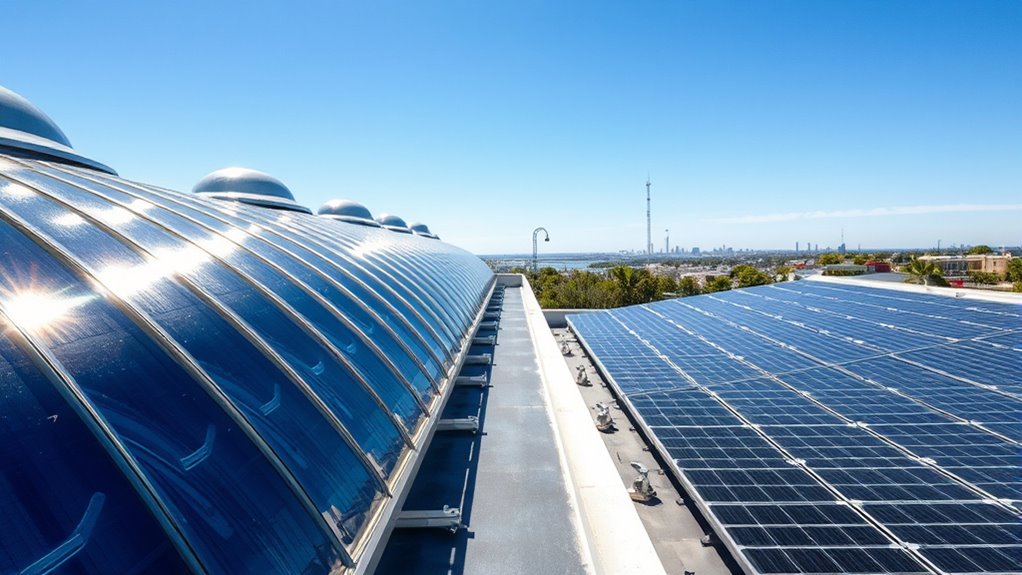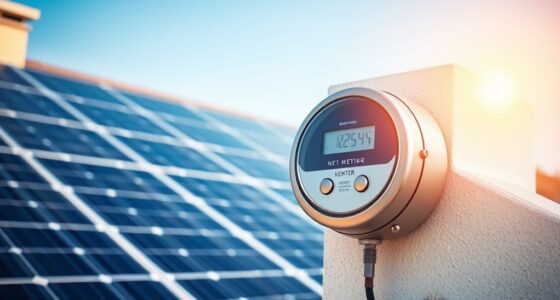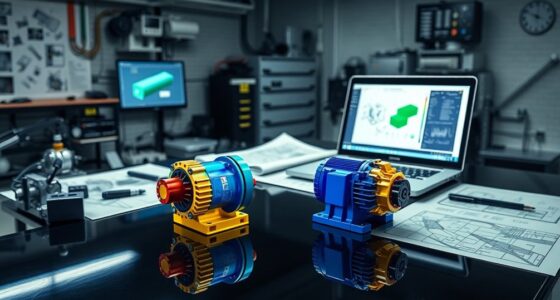Solar thermal and PV systems both use sunlight but serve different purposes. Solar thermal collects heat directly for hot water or heating, typically with simpler and cheaper setups. PV panels convert sunlight directly into electricity, suitable for powering devices or feeding into the grid. Your choice depends on whether you need heat or electricity. To discover which system fits your needs best and explore their features more closely, keep exploring further.
Key Takeaways
- Solar thermal systems convert sunlight into heat for hot water or heating, while PV systems generate electricity directly from sunlight.
- Solar thermal systems generally have lower upfront costs and are more suitable for heating applications.
- PV systems tend to be more complex to install, requiring wiring, inverters, and permits, but produce electricity for multiple uses.
- Solar thermal has fewer components and is easier to maintain, whereas PV systems can generate excess power for grid feed-in.
- Choice depends on primary energy needs: thermal for hot water/heating, PV for electricity generation.

When choosing between solar thermal and photovoltaic (PV) systems, understanding their fundamental differences is essential. Both options harness sunlight to generate energy, but they do so in distinct ways, impacting your decision based on cost efficiency and installation complexity. Solar thermal systems primarily convert sunlight into heat, which you can use directly for hot water or space heating. They typically consist of collectors, usually mounted on your roof, that absorb solar energy and transfer it to a fluid. In contrast, PV systems convert sunlight directly into electricity through solar panels made of semiconductor materials. This electricity can power your home or be fed back into the grid.
From a cost efficiency standpoint, solar thermal systems often offer a more economical solution if your main goal is hot water or heating. They tend to have lower upfront costs compared to PV setups because the technology is more straightforward and specialized for heating purposes. Plus, they usually require less maintenance over time, which contributes to their overall cost savings. However, if you’re looking to generate electricity for a variety of household needs, PV systems might be more cost-effective in the long run, especially as the price of solar panels continues to decrease. PV installations can also produce excess electricity that you can sell back to the grid, providing potential financial benefits and offsetting installation costs.
When it comes to installation complexity, solar thermal systems are generally simpler to set up. They involve fewer components, and their installation process is more straightforward, often fitting into existing hot water systems with minimal modifications. This simplicity results in shorter installation times and less labor involved, which can reduce overall costs. PV systems, on the other hand, require more extensive setup. You’ll need proper mounting structures, electrical wiring, inverters, and sometimes additional permits or inspections. The complexity of installing PV panels can lead to longer installation times and higher labor costs, especially if your roof isn’t ideally suited or if electrical systems need significant upgrades.
Frequently Asked Questions
Which System Has Lower Long-Term Maintenance Costs?
You’ll find that PV systems generally have lower long-term maintenance costs compared to solar thermal systems. Their cost comparison shows fewer moving parts, which means less wear and tear. Durability factors also favor PV, as panels are designed to withstand harsh weather conditions with minimal upkeep. With regular inspections and cleaning, PV systems remain efficient and cost-effective over time, making them a smarter choice for minimizing ongoing maintenance expenses.
How Do Installation Times Compare Between Solar Thermal and PV?
Imagine a sunny day, and your system is ready to harness that energy. When comparing installation times, PV systems usually set up faster, thanks to their straightforward setup duration and modular design. Solar thermal installations tend to take longer, as they require precise plumbing and collector placement. So, if you’re looking for quick deployment, PV offers a faster installation speed, getting you up and running sooner.
Can Both Systems Be Integrated Into Existing Energy Setups?
Yes, you can integrate both systems into your existing energy setup through hybrid integration. This approach allows you to combine solar thermal and PV systems, maximizing energy efficiency. You should also consider adding energy storage solutions to balance supply and demand, especially during cloudy days or at night. Properly integrating these systems can improve overall performance and reduce your reliance on grid power, making your energy setup more sustainable.
What Are the Environmental Impacts of Manufacturing Each System?
Manufacturing each system impacts the environment through resource depletion and manufacturing emissions. PV panels require significant amounts of silicon, rare metals, and energy-intensive processes, leading to higher resource depletion and emissions. Solar thermal systems generally have lower manufacturing impacts but still involve metal and glass production. Overall, both contribute to environmental strain during manufacturing, but PV systems tend to have a larger footprint due to complex material needs and energy use.
How Do Efficiency Rates Vary With Different Climates?
You’ll notice efficiency rates vary with different climates due to climate adaptability. In hot, sunny regions, PV panels often perform better, with efficiency fluctuations being minimal. Conversely, in colder or cloudier areas, solar thermal systems may maintain steadier performance because they rely on heat rather than sunlight intensity. Understanding these variations helps you choose the system that maximizes energy output based on your local climate, ensuring peak efficiency year-round.
Conclusion
Think of solar thermal and PV as two different artists painting your energy future. Solar thermal is like a warm summer breeze, gently heating your needs, while PV is a vibrant sunrise, transforming sunlight directly into power. Each has its own charm, but together, they’re like a symphony of the sun’s energy—powerful, harmonious, and ready to light up your life. Embrace both, and watch your energy landscape blossom with the sun’s endless promise.










